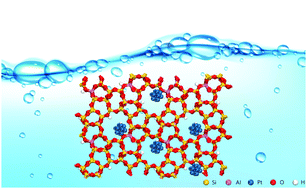Theoretical characterization of zeolite encapsulated platinum clusters in the presence of water molecules†
Abstract
Zeolite encapsulated metal clusters have shown high catalytic activity and superior stability due to confinement effects, the synergy between acidic and metal active sites, and strong metal–zeolite interactions. In the present work, density functional theory calculations were employed to study the stability of encapsulated Ptn (n = 1–6) clusters in the zeolitic frameworks including Silicalite-1 and H-MFI. It has been found that the metal-zeolite interaction becomes stronger with the increasing Ptn cluster size for both zeolitic frameworks. The encapsulated Ptn clusters in the vicinity of the Brønsted acid site (BAS) of H-MFI form more stable PtnHx (x = 1, 2) clusters. The presence of water molecules around the encapsulated Pt6 cluster further enhances its stability, while the oxidation states of the encapsulated Ptn cluster are largely affected by the BAS site and the surrounding water molecules. As the water concentration increases, water dissociation becomes more facile on the Pt6@Silicalite-1 cluster while an opposite trend is found over the Pt6H2@H-MFI cluster. The proton of the BAS site can be transferred to the encapsulated Pt6 cluster via a hydronium cluster H+(H2O)n, leading to the formation of the Pt6H2@H-MFI cluster.



 Please wait while we load your content...
Please wait while we load your content...